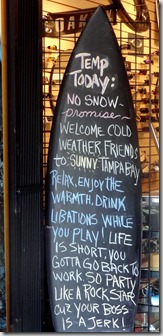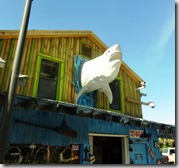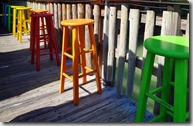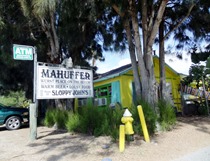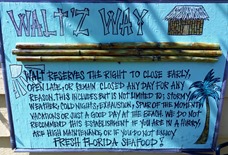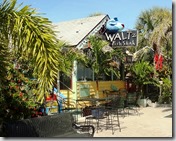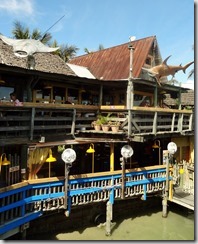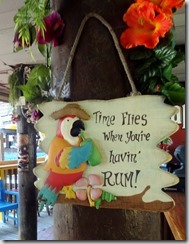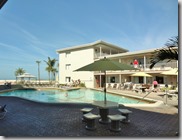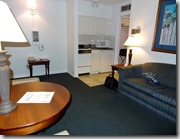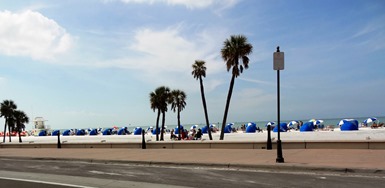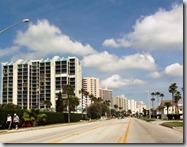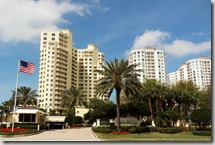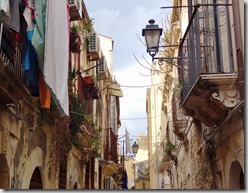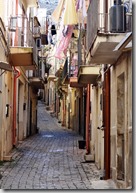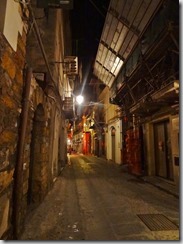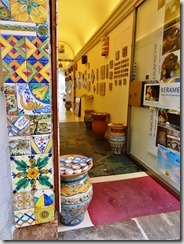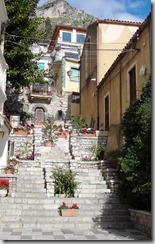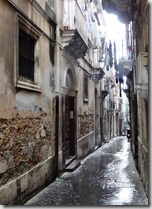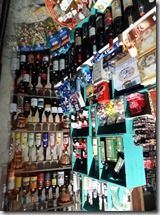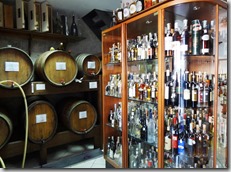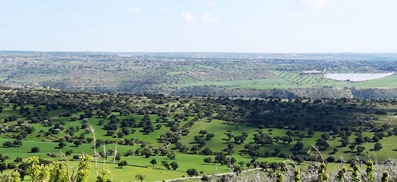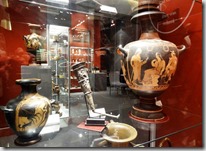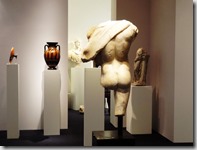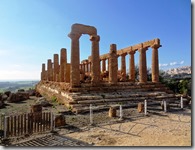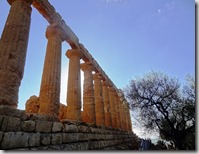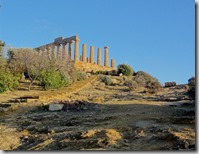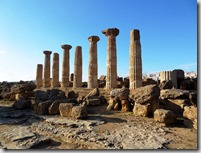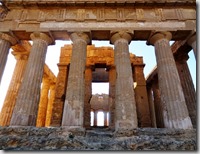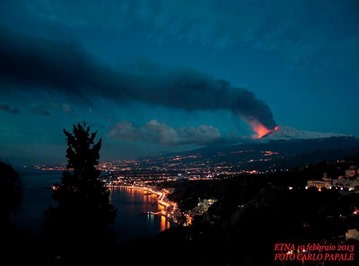Part of the eternal fun of going to Florida is the bright colors and cheezy signs. It’s a vacation mindset, accenting the warm weather and blue skies, too long absent in Europe this winter, with light sayings and breezy ornamentation.
Traditional Florida
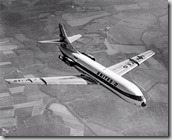 My first airplane trip was on a family vacation to St. Augustine, Florida, probably in 1960 or so. We flew down on a Carvaelle jet, two engine pods at the back rather than under the wings, a very cool step up from the prop planes of the time. We stayed right on the beach in a two-story hotel embracing a freshwater swimming pool: I remember a lot of pink and coral colors.
My first airplane trip was on a family vacation to St. Augustine, Florida, probably in 1960 or so. We flew down on a Carvaelle jet, two engine pods at the back rather than under the wings, a very cool step up from the prop planes of the time. We stayed right on the beach in a two-story hotel embracing a freshwater swimming pool: I remember a lot of pink and coral colors.
Treasure Island beaches, outside of Tampa, haven’t changed much since those days.
The Thunderbird Resort is a funky throwback, 50-ish room deor, a smell of warm molds and cold air conditioning, a kitchenette with hotplate burners and a stainless steel sink. The two story hotel wraps around a deep blue pool, open at the ends to the ocean. Miami-Vice pastel colors dominate. Patrons are a blend of young families and older retirees. (‘Funny that I think of them as ‘older’ now, rather than just ‘old’.)
But it all works in a comfortable / nostalgic sort of way.
Beyond the resort, Treasure Island is lined with low-rise hotels and beach houses on the ocean side of highway A1A, local restaurants and beach shops on the leeward side of the street. The whole thing is lined with palm trees, ornamented with gardens, and very much on a human scale. It invites walking, exploring, discovering.
South, towards Clearwater (Spring Home Of The Phillies), contemporary high-rises crowd the shore, a high wall blocking off the ocean and the sunshine. Gates and guards are the norm to protect the residents from visitors. Across A1A, strip malls line the road with chain restaurants and national housewares stores. Nobody walks the streets: there’s only the comfortably familiar and safe.
Deceptively safe.
Artificial intelligence researchers reduce product selection and purchasing transactions to template scripts that we execute unconsciously from years of practice. Years of expatriate life have replaced my New World scripts with Old World ones, and this trip I felt wholly out of sync.
The McDonalds breakfast menu was a maze: McMuffin, McBiscuit, McGriddle. In trying to ask about the differences, I accidently ordered all three. Two of them were horrible.
I bought a bottle of wine in Target, the clerk asked to see my driver’s license. I played it straight an handed over the US version. She inspected the birthdate, then scanned the 2D bar code on the back. All of my personal information into their databases. “What if I didn’t let you scan the code?” Then you wouldn’t be allowed to buy alcohol. ‘Frightening both ways.
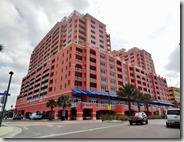 So it went: Ruby’s restaurant, a bank deposit, a booking change with Delta. Each had new steps, unfamiliar checks, a different script.
So it went: Ruby’s restaurant, a bank deposit, a booking change with Delta. Each had new steps, unfamiliar checks, a different script.
Some things change in a few years; other’s don’t change for decades. Americans still fly to Florida in jets.
And they still drive on the ‘wrong’ side of the road…
Italian alleyways
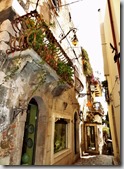 I used to really key in on the Italian countryside, then the charming towns that cap hills like snow and tumble down valleys to the sea.
I used to really key in on the Italian countryside, then the charming towns that cap hills like snow and tumble down valleys to the sea.
And I still do, but increasingly I look for the jumbled alleys and local faces, the colored shadows and earnest conversations.
And Sicily was filled with them.
And, after exploring the alleyways, it’s time to retreat to the cellars.
Sicilian impressions
 I have admit that Sicily was a whim. There were cheap airfares straddling the route between Maastricht and Stansted, the weather promised to be warm(ish), and I was ready for a long weekend free of Boards and Contracts. Living in Europe means Doing Europe when the opportunity presents, spending a bit of treasure on Experiences rather than Things in pursuit of happiness.
I have admit that Sicily was a whim. There were cheap airfares straddling the route between Maastricht and Stansted, the weather promised to be warm(ish), and I was ready for a long weekend free of Boards and Contracts. Living in Europe means Doing Europe when the opportunity presents, spending a bit of treasure on Experiences rather than Things in pursuit of happiness.
Sicily delivers.
The countryside is incredibly varied, from sparkling Mediterranean shores to cloudy snowblown mountain peaks. It’s not a large island and the motorways that cross the interior put the entire province within half a day’s drive. Coastal roads take longer, but I’d be slowing down anyway just to admire the views or to pull off into a village
Motorists are something else: one guidebook described them as driving like ‘dogs on drugs’. That’s kind.
Signage is somewhere between intermittent and misleading: a sequence of pointers to a town suddenly end miles short of the destination, others lead to closed roads. I don’t know if Sicily never had good signage, or they let the labeling decay when car navigation arrived.
Not that TomTom is much better: I found myself perched at the top of a flight of stairs leading down a village street one hapless night.
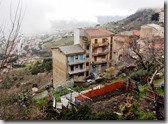 Sicily looks like a place that should be heavily forested, but there are none. Articles suggest that when the Romans converted the island to agriculture, the rainfall declined and the rivers dried. The potential for desertification seems real, and is a major concern for Sicily’s future.
Sicily looks like a place that should be heavily forested, but there are none. Articles suggest that when the Romans converted the island to agriculture, the rainfall declined and the rivers dried. The potential for desertification seems real, and is a major concern for Sicily’s future.
Today’s problem, though, is Garbage. For some reason, the locals throw it *everywhere*. It lies in haps along the roads, piles in drifts at rest stops, crowds the alleys and fences. It is absolutely beyond me why people allow this, although I suppose that once some do, then everyone will.
There is also a creeping blight of unfinished cement buildings, just columns ad floors with no further work ongoing, and the “Spanish disease” of white plastic greenhouses force-germinating tomatoes and fruits.
![]() The people are incredibly friendly, quick with a smile, a welcome, a recommendation, or a story. English was generally good, better than most of the rest of Italy, never a problem in hotels, only occasionally difficult in restaurants. People are masterful line jumpers, who can advance through a queue at twice the rate of anyone else.
The people are incredibly friendly, quick with a smile, a welcome, a recommendation, or a story. English was generally good, better than most of the rest of Italy, never a problem in hotels, only occasionally difficult in restaurants. People are masterful line jumpers, who can advance through a queue at twice the rate of anyone else.
 Food was outstanding: local cuisine leans heavily towards hearty fish dishes, whether salads, appetizers, or mains. Wines were full and fruity, very cherry: the house wines were almost always excellent. Prices were moderate, generally about 20-25 euro for sit-down lunch or dinner.
Food was outstanding: local cuisine leans heavily towards hearty fish dishes, whether salads, appetizers, or mains. Wines were full and fruity, very cherry: the house wines were almost always excellent. Prices were moderate, generally about 20-25 euro for sit-down lunch or dinner.
A good introduction to both the culture and food of Sicily is “Sicily Unpacked”, a 3-part BBC special with British art critic Andrew Graham-Dixon and Italian chef Giorgio Locate. (I would much rather be traveling with Giorgio than Graham).
Pictures up shortly at my Flickr site.
Amongst the Greeks
This is my usual experience with the Greeks: urns and statues in museums. I can tell the difference between earlier “black-figure” urns and later “red-figure” urns, ruminate on the virtues of three-phase firing techniques, can occasionally distinguish a Skyphos from a Kanthros.
It’s all a bit abstract and technical, even philosophical (Platonic idealisms).
I’ve never been to Greece: it’s on my wish-list, but always too expensive, too far, too complex in planning. The ancient Greeks, though traveled widely, and dropped anchor in the Valley of the Temples, outside of present-day Agrigento. 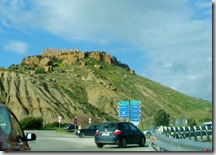 Like Pompeii, it’s a site that evokes real life, massive stone buildings and blocks of carvings, and the setting of the time, amidst flowering almonds overlooking the sea.
Like Pompeii, it’s a site that evokes real life, massive stone buildings and blocks of carvings, and the setting of the time, amidst flowering almonds overlooking the sea.
The monuments are first visible high on ridges above the coast highway; a winding side road brings you up to the entrance, parking area, souvenir stands, and ticket booth. Access is no fun: fees that seem arbitrary, multiple ticket checks within a yard of one another, poor signage overall. But once inside, I just got lost in the compositions of stone Doric columns, flowering trees, and sunset light.
The temples were built in the 5th century BC, and were subsequently destroyed several times before being restored to their present form by a British patron, Sir Alexander Hardcastle, in the 1930’s. There are recent, curious, inactive) water sculptures scattered between the temples, and excavated storerooms beneath the hill.
But the temples themselves, glowing tan and orange, the wind sighing through the columns, the distant glimpse of interior alters, really stand alone and above all other parts. It’s wonderful 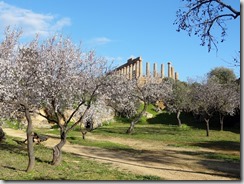 to think about and photograph from almost any angle, it’s easy to see why they chose the spot and how it evokes feelings of connection and transcendence away from the bustle of the ports and market towns.
to think about and photograph from almost any angle, it’s easy to see why they chose the spot and how it evokes feelings of connection and transcendence away from the bustle of the ports and market towns.
How sunrise should look every morning
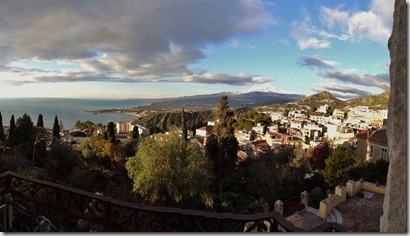 Looking south across Taormina to Mt. Etna, smoking ahead of it’s recent eruption.
Looking south across Taormina to Mt. Etna, smoking ahead of it’s recent eruption.
The current view, above, and my morning’s-eye view a week ago, below.

